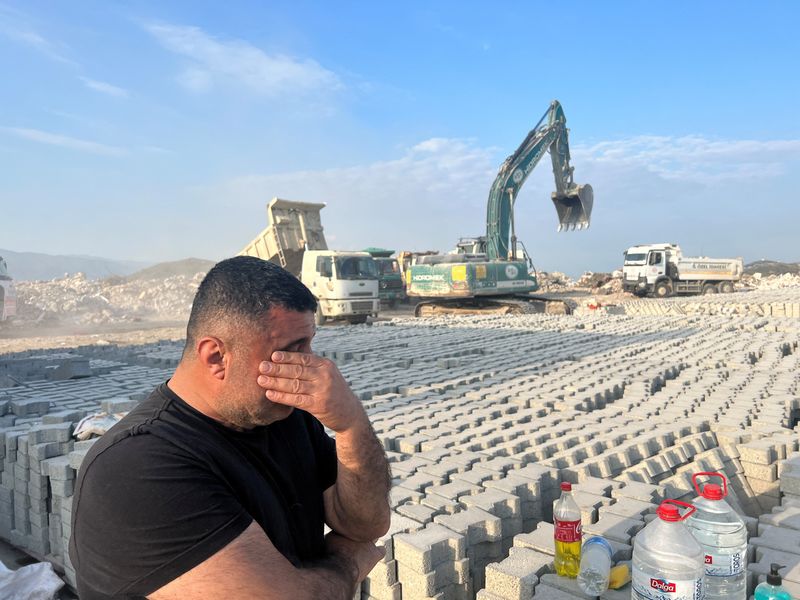By Ece Toksabay and Timour Azhari
ANTAKYA, Turkey (Reuters) – After the deadliest earthquake in its modern history, Turkey faces the daunting task of disposing of hundreds of millions of tonnes of rubble, some of it potentially harmful.
The Feb. 6 earthquake and aftershocks left at least 156,000 buildings either completely collapsed or damaged to the point where they require demolition, Turkish authorities said, with whole areas of cities reduced to shattered concrete and steel.
The U.N. Development Program (UNDP) says the resulting 116- 210 million tonnes of rubble are equivalent to an area of 100 square km (40 square miles), if it were stacked to a height of 1 metre. That is roughly the size of Barcelona.
Turkish President Tayyip Erdogan, facing an election likely to be held on May 14, has pledged to rebuild homes within a year, although experts warned safety should come before speed.
An official said tenders and contracts had already been completed for some projects and safety would not be compromised.
In many cities, rescue teams have been replaced by thousands of trucks and excavators that claw away at the mountains of concrete. Workers in the city of Antakya, in Hatay province said it can take several days to clear the debris of one building.
“The scope of the challenge is almost beyond comprehension,” UNDP Resident Representative Louisa Vinton said in a statement. The UNDP said the disaster generated at least 10 times as much rubble as the last big Turkish earthquake in 1999.
Much of the rubble that has so far been removed has been stored in nearby temporary dumps, raising concerns about contamination. There are fears that older building material may contain asbestos, a cancer-causing fibre banned in many countries, including in Turkey, several experts told Reuters.
Deputy Environment Minister Mehmet Emin Birpinar said in a tweet that dust suppression systems were being used to prevent harmful substances like asbestos from circulating.
Reuters journalists observed some water trucks hosing down debris as it was lifted into trucks in cities including Antakya and Osmaniye, but in many other cases, there were no such measures. Birpinar could not immediately be reached for comment.
ENVIRONMENTAL WARNINGS
Proximity and convenience are a main factor when choosing the location of dump sites, according to three people directly working in rubble removal in the southern city of Antakya.
But Ahmet Kahraman, Chairman of the Chamber of Environmental Engineers, said where debris is stored required “meticulous study” by geological and environmental experts.
Some environmental activists and opposition politicians warn that improper clearance of rubble could lead to ecological disaster. At least one site, visited by Reuters, was a wooded area.
“Dumping rubble in the city, olive groves and stream beds without decomposing and recycling it causes new environmental disasters,” said Gokhan Gunaydin, of the opposition CHP party.
Birpinar said on Twitter last Friday that the areas selected for debris disposal in Hatay were far from agricultural and residential areas, as well as wetlands and protected areas.
So far, 19 temporary sites had been identified in Hatay, with a total area the size of 200 football fields and 150,000 cubic metres of rubble were being moved per day, he added.
This week, hundreds of rubble trucks drove into the hills east of Antakya, unloading it in sites near lush greenery and olive trees.
Altan Arslan, a 51-year-old who owns a pavement brick and cement block factory, said he had donated his land to the government to use to store rubble after the quake.
He said thousands of trucks arrived daily and the rubble had grown into a massive mound. Bulldozers then flattened the waste and pushed it towards a cliff side, sending some debris tumbling into the valley and creating large clouds of dust.
“We may need a couple more fields like this because the destruction is huge,” Arslan said, as excavators discarded shattered concrete near stacks of new cement blocks in his yard.
Local people were much too traumatised immediately after the quake to worry about where rubble was being dumped, he added.
His factory helped build Antakya, but the land on which it stood had now become the city’s graveyard.
“We were very happy while making this city, but seeing it collapse like this…”. He put his hand on his face and sobbed.
(Reporting by Timour Azhari and Ece Toksabay in Antakya, Editing by Alexandra Hudson and Andrew Heavens)



